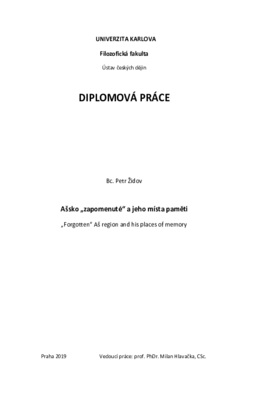Ašsko "zapomenuté" a jeho místa paměti
"Forgotten" Aš region and his places of memory
diplomová práce (OBHÁJENO)

Zobrazit/
Trvalý odkaz
http://hdl.handle.net/20.500.11956/110654Identifikátory
SIS: 175421
Kolekce
- Kvalifikační práce [24008]
Autor
Vedoucí práce
Oponent práce
Pokorná, Magdaléna
Fakulta / součást
Filozofická fakulta
Obor
Historie - české dějiny v evropském kontextu
Katedra / ústav / klinika
Ústav českých dějin
Datum obhajoby
11. 9. 2019
Nakladatel
Univerzita Karlova, Filozofická fakultaJazyk
Čeština
Známka
Velmi dobře
Klíčová slova (česky)
Aš|Ašsko|místa paměti|kolektivní paměť|paměťová studiaKlíčová slova (anglicky)
Aš|Aš region|places of memory|collective memory|memory studiesMěsto Aš, potažmo celý ašský region, byly téměř po celou svou doloženou historii místem, jež bylo nepřetržitě obýváno obyvatelstvem německé národnosti, které muselo nuceným vystěhováním po konci druhé světové války opustit své domovy, jež byly generacemi budovány a předávány kontinuálně dalším nositelům specifických tradic tohoto regionu. Staletí přetrvávající kontinuita obyvatel s tímto krajem byla násilně zpřetrhána. Zůstala tak sídla a místa, která ztratila svou paměť. Nové obyvatelstvo si muselo vztah k tomuto kraji postupně zcela nově vybudovat. Tato práce si vytkla cíl zmapovat místa paměti, která se vázala díky nacionálnímu a náboženskému charakteru regionu zcela k německé historii a na jejich příkladu zjistit, jakým způsobem se vyvíjel vztah vyměněného obyvatelstva ke svému novému působišti po roce 1945 a zejména pak po roce 1989, kdy se mohlo začít díky uvolnění politických poměrů k problematice starých i nových míst paměti přistupovat otevřeněji.
The town Aš, its whole region, used to be the place permanently inhabited by people of German origin, as all the historical documents report. After the end of the world war two, people of German origin were forced to leave their homes which were built and handed over throughout the centuries and therefore became the prominent bearers of Aš region tradition. This long lasting continuity of inhabitation by these people was unnaturally intrerrupted and many places and settlements lost their memories. The new residents had to build the relationship to their new homes from the beginning. The aim of this thesis is to describe the places of memory which are, owing to nationalistic and religious character of the region, entirely tied to German history, and by means of their analysis find out how the newcomers' relationship to their new homes developed. The focus will be taken on the time period after 1945 and, especially, time period after 1989 when, on account of easing political situation, the new and old memory places could be viewed more objectively than before.
